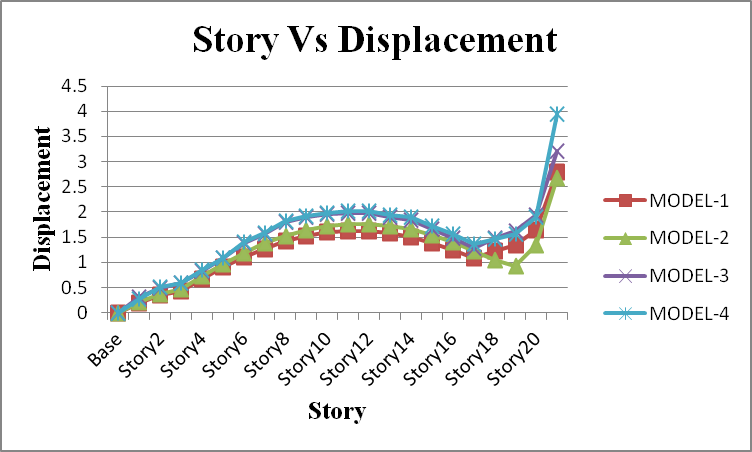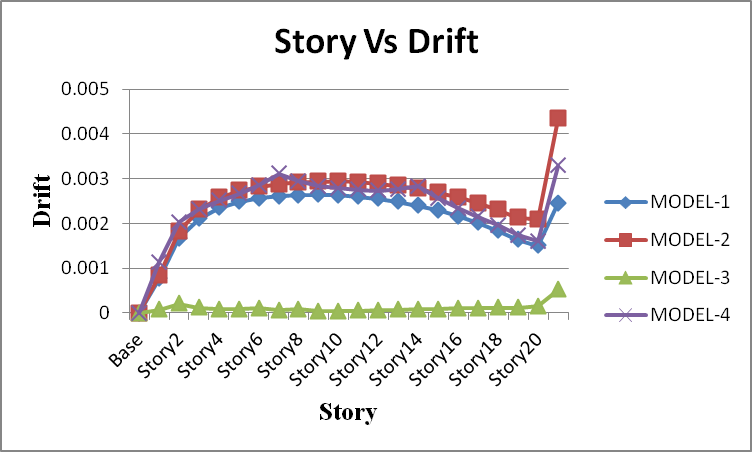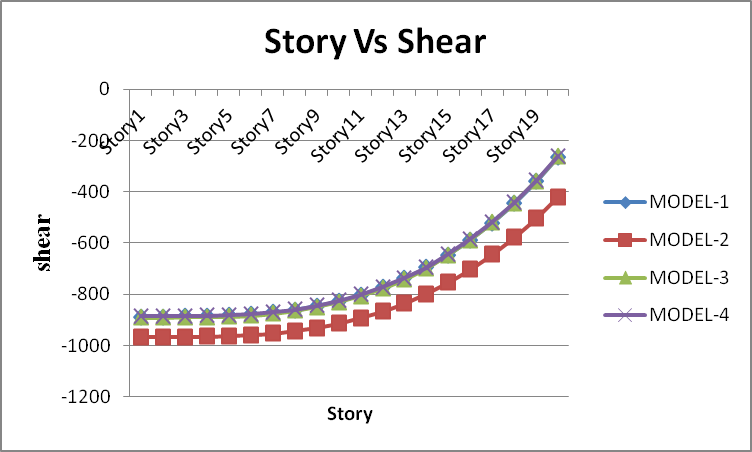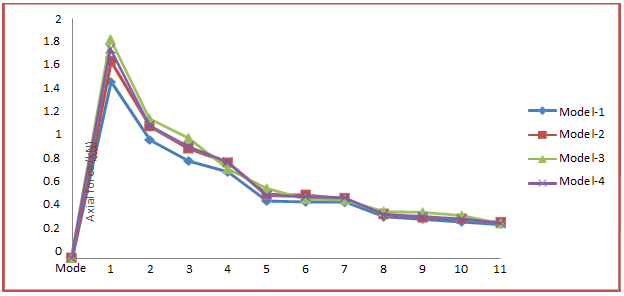Ijraset Journal For Research in Applied Science and Engineering Technology
- Home / Ijraset
- On This Page
- Abstract
- Introduction
- Conclusion
- References
- Copyright
Non-Linear Time History Analysis of Irregular Shaped Building
Authors: Yogini Vijaysing Thakur, Prof. Sandip B. Chavan
DOI Link: https://doi.org/10.22214/ijraset.2025.66858
Certificate: View Certificate
Abstract
Earthquake considerations are vital in the design of every structure. Many researchers have reported research works aiming to understand the impact of structures with various irregularities. This study focuses on the behavior of structures with irregularities and compares G+20 models of regular and irregular structures. The response spectrum analysis method is used for analysis, and all structures are assumed to be in Zone V with medium soil type. The ground motion data of the El-Centro earthquake in 1940 is used for the study. The analysis is conducted using the Etabs software. The study examines the structures’ responses to ground motion in terms of story displacement, story drift, and base shear. The responses of each type of building are studied and compared. The results indicate that ground motions with low-frequency content have a significant impact on both regular and irregular reinforced concrete structures. It is observed that irregularly shaped structures lead to an increase in displacement, drift, story acceleration, time-period, and member forces, while reducing the base shear. This study suggests that when planning for earthquakes, irregularly shaped structures require extra attention to avoid further losses.
Introduction
I. INTRODUCTION
An earthquake is a sudden tremor of the earth, caused by the displacement of tectonic plates in the earth's crust. It is known that various types of irregularities in buildings are used in modern infrastructure. In the event of an earthquake, high forces are applied to the structure; the structure is usually designed to experience settlement. When an earthquake occurs, buildings tend to collapse. This is mainly due to discontinuity in geometry, mass and stiffness or several different factors. This discontinuity is defined as an irregular structure. According to building regulations, structures must be designed to withstand a certain intensity of ground acceleration, with the intensity of ground motion depending on the seismic hazard. The main objective of earthquake engineering is to minimize the loss of life due to structural collapse.
Nowadays it is very common during the design of structures that anyone can request a variation of the shape. So, to fulfill their request, a designer can suggest any shape. As the shape of the building changes, irregularities may need to be addressed. As per IS 1893:2002 clause 7.1, which states that to function properly in an earthquake, a building must have four main attributes, namely a simple and regular configuration and adequate lateral strength, stiffness and ductility. Buildings with simple and regular geometries and uniformly distributed mass and stiffness in both the plan and elevation experience significantly less damage than buildings with irregular configurations. A building is considered irregular for the purposes of this standard, if at least one of the conditions is met. Irregularities can be of any type (according to IS 1893:2002, tables no. 4 and 5, page no. 18) Therefore the designer must pay close attention to these irregularities. The types of deviations can be in the following types.
The behavior of a building during earthquakes depends critically on its overall shape, size and geometry, in addition to how the earthquake forces are carried to the ground. The earthquake forces developed at different floor levels in a building need to be brought down along the height to the ground by the shortest path; any deviation or discontinuity in this load transfer path results in poor performance of the building. Buildings with vertical setbacks cause a sudden jump in earthquake forces at the level of discontinuity.
Buildings that have fewer columns or with an open ground storey intended for parking collapsed or were severely damaged in Gujarat during the 2001 Bhuj earthquake. Buildings with columns having stiffness irregularity or hang or float on beams at an intermediate storey and do not go all the way to the foundations have discontinuous in the load transfer path.
A regular structure can be investigated to have uniformly distributed mass, stiffness, strength and structural form. When one or more of these properties is non-uniformly distributed, either individually or in combination with other properties in any direction, the structure is referred to as being irregular.
A. Types of Irregularity
1) Plan Irregularity
This is divided into the following types
Torsional deviation: Should be considered when the floor diaphragm is rigid in its own plane with respect to vertical structural elements resisting lateral forces. Torsional irregularity is considered to exist when the maximum floor drift, calculated by the design eccentricity, at one end of the structure transverse to the axis is greater than 1.2 times the average floor drift at both ends of the structure.b) Re-entrant Corners: the design configuration of the structure and its systems that are resistant to lateral forces contains a re-entry angle, in which the two projections of the structure beyond the re-entry angle are greater than 15% of the design dimensions in the given direction.c) Diaphragm Discontinuity: Diaphragms with discontinuities or sudden changes in stiffness, including those with an open or cut area greater than 50% of the gross area of the closed diaphragm, or a change in effective diaphragm stiffness of more than 50% from plane to plane.d) Out-of-Plane Offsets: Discontinuities in the path of lateral force resistance, such as offsets of vertical elements out of plane.e) Non-parallel Systems: Vertical elements resisting lateral forces are not parallel or symmetrical about the principal orthogonal axis or elements resisting lateral forces.
2) Vertical Irregularity
This type of irregularity is further subdivided into the following types as well
Stiffness Irregularity a) Soft Storey:- Soft storey is a plane whose lateral stiffness is less than 70% of the upper plane or less than 80% of the average lateral stiffness of the three upper planes. b) Stiffness Irregularity — b) Extreme Soft Storey:- Extreme Soft Storey is one where the lateral stiffness is less than 60% of the upper deck or less than 70% of the average stiffness of the three upper planes. For example, a stilt building would fall into this category. c)Mass Irregularity: Mass irregularity is considered to exist when the seismic weight of one floor is greater than 200% of the seismic weight of the adjacent floor. Irregularity should not be considered in the case of hedging. d) Vertical Geometric Irregularity: Vertical geometric irregularity is considered to exist when the horizontal dimension of the lateral force resisting system in one plane is greater than 150% in the adjacent plane. e) In-Plane Discontinuity in Vertical Elements Resisting Lateral Force: Offset in the plane of the lateral force resisting element that is greater than the length of the element.
II. LITERATURE REVIEW
“Seismic Response of Vertically Irregular Structures” see on their exploratory investigation in (1983), Seismic reaction of four irregular reinforced concrete test structures is deciphered utilizing static examination techniques. The four test structures were worked on models of multi-story building outlines containing frames and frame wall combinations. Discontinuities in the vertical plane of the constructions were presented by ending the underlying walls at different levels. It is discovered that standard cutoff examination and static inelastic investigation give great proportions of strength and deformation qualities under solid earthquake movements.
“Limitation of irregular structure for seismic response” (2013) a post graduate student investigated on too long and too tall structures are modeled by using commercial software, loads are applied and a pushover analysis was carried out. The results of the pushover curve and inter storey drift are obtained to study the performance of the building. Too long & too tall buildings are avoided in the earthquake prone area due to low performance limit.
“Seismic Demand of Steel Structures with Mass Irregularity” [31] this study effects on mass irregularity is an important factor affecting structural responses under seismic loads. In this paper, the seismic responses obtained from linear analyses (static analysis and response spectra analysis) are compared with exact solution from nonlinear time history analyses. Also the nonlinear time history analysis are carried out to study the nonlinear response of 5, 10 and 15 stories buildings with vertical mass irregularity. The mass irregularity is created by increasing the effective mass (weight) of some floors relative to other floors (2 or 3 time). These floors with additional masses can be located in the first floor, middle floors or upper floors of the building. The drift of stories, plastic hinge rotation and internal forces of columns in the middle frame are investigated. The results show that the linear seismic demand estimated by response spectra analysis is less than seismic demand determined by equivalent static analysis. Also the nonlinear seismic response of building with mass irregularity is varying relative to location and amount of irregularity and it is dependent on the earthquake record selection. Furthermore, buildings with vertical mass irregularity usually demonstrate lower performance than the regular buildings.
“Evaluation of the Influence of Vertical Irregularities on the Seismic Performance of a 9 - storey steel frame” (2012) this study based on Incremental Dynamic Analysis (IDA) is presented for the evaluation of structures with vertical irregularities. Four types of storey- irregularities are considered: stiffness, strength, combined stiffness and strength, and mass irregularities. Using the well- known 9-storey LA9 steel frame as a base, the objective is to quantify the effect of irregularities, both for individual and for combinations of stories, on its response. In this context a rational methodology for comparing the seismic performance of different structural configurations is proposed by means of IDA. This entails performing nonlinear time history analyses for a suite of ground motion records scaled to several intensity levels and suitably interpolating the results to calculate capacities for a number of limit-states, from elasticity to final global instability. By expressing all limit -state capacities with a common intensity measure, the reference and each modified structure can be naturally compared without needing to have the same period or yield base shear. Using the bootstrap method to construct appropriate confidence intervals, it becomes possible to isolate the effect of irregularities from the record-to- record variability. Thus, the proposed methodology enables a full-range performance evaluation using a highly accurate analysis method that pinpoints the effect of any source of irregularity for each limit-state.
“Study of Response of Structurally Irregular Building Frames to Seismic Excitations” (2012) evaluate the response of structurally irregular building frames to seismic excitations with the help of IS 1893: 2002 Part-1. The models are being modeled considering to the regular with stiffness & mass irregularity and compared their story drift, story shear & story displacement. These models ar modeled by using the ETABS Software. Based on these findings, some guidelines are proposed to make buildings safer to seismic excitations.
“Comparative Analysis Of Rc Irregular Buildings Designed According To Different Seismic Design Codes” (2012) investigation presents a comparison of the seismic provisions of the three seismic design codes, namely the Philippine code (National Structural Code of the Philippines or NSCP2010), the European code (Eurocode 8 or EC8), and American code (2009 International Building Code or 2009 IBC), to the most common ordinary residential building of standard occupancy. Two regular and irregular reinforced concrete (RC) frames were analysed and compared for four storey and eight storey buildings. The response spectrum function of NSCP 2010 was considered for the horizontal load action with different load combinations. Response spectrum analysis was performed using SAP2000 software package. Five representative columns for each RC frames were analyzed and based from the results of column axial load - bending moment interaction diagrams, EC8 was found to be conservative as compared to NSCP 2010 and 2009 IBC. The conclusion is that for the design and analysis of ordinary RC residential building with certain irregularity, EC8 provisions were considered to be safer.
“Effect of Irregular Configurations on Seismic Vulnerability of RC Buildings” (2012) this study made an attempt to study two kinds of irregularities in the building models namely plan irregularity with geometric and diaphragm discontinuity and vertical irregularity with setback and sloping ground. These irregularities are created as per clause 7.1 of IS 1893 (part1)2002 code. In Oder to identify the most vulnerable building among the models considered, the various analytical approaches are performed to identify the seismic demands in both linear and nonlinear way. It is also examined the effect of three different lateral load patterns on the performance of various irregular buildings in pushover analysis. Here different types of plan & vertical irregularities are taken for the analysis by equivalent lateral force method & response spectrum method by using the ETABS. The equivalent static method doesn’t consider the irregular effects in the building and since it depends only on empirical formula the results obtained will be abnormal in comparison to response spectrum method. 2. The eccentricity between center of mass and center of rigidity varies even though in the absence of dual systems i.e. shear walls. 3. In pushover analysis the codal type of vertical distribution of lateral force was found more detrimental in low rise models. Since more number of hinges are formed for a given displacement level compared to the other two patterns. 4. The performances of all the models except sloping ground (V5 and V6) are lies in between life safety and col-lapse prevention. This shows the buildings resting on sloping ground are more vulnerable to earthquake than rest of the models. 5. The result also shows that, capacity of the buildings may be significant but the seismic demand varies with respect to the configurations.
“Assessment of Collapse Safety of Stiffness Irregular SMRF Structures According to IDA Approach” (2012) studied that incremental dynamic analysis is applied to estimate response of stiffness irregular structures to seismic loads. IDA presents response of structure from elastic to dynamic instability. According to Performance Based Earthquake Engineering, collapse capacity of structure is established. Collapse capacity is minimum ground motion intensity which causes dynamic instability of structural system and inability of structural components to carry gravity loads. By comparison of expected collapse capacity of maximum considered earthquake and stiffness irregular structures, collapse safety is evaluated. Lower ratio between MCE and considered irregular structures indicate to lower collapse safety of structure.
For this purpose by focusing on eight stories steel moment resisting frame structure with stiffness irregularity, it is understood which location of stiffness irregular story is important. Stiffness irregularity in lower stories has more effects on response of structure than intermediate stories and leads to lower collapse safety.
III. PROBLEM STATEMENT
The problem considered for the current review is taken from IS 1893-section 1: 2016 is the vertical geometric irregular structure model is considered for displaying reason and the area is considered in India having severer seismic zone (Seismic Zone V) is chosen for the current review. This structure model is a G+20 story building is made of Supported cement (RC) Unique second opposing edge (SMRF). The section thickness is 150 mm at each floor. The definite depiction is as displayed in the Table 1.
Frame is considered with three different irregularity as taken from IS 1893-part1: 2016. Thus, we have four frames including the base frame. These four frames have been analyzed using equivalent static method and response spectrum method of IS 1893-part 1: 2016 while assuming seismic zone V, and importance factor 1.0. Analysis has been carried out using commercial software ETABS program.
Table 1: Structural composition of regular shaped G+20 building
|
Specification |
Details |
|
1 Type of structure |
Composite Structure (Beam and column are composite in nature) |
|
2 Seismic zone |
V |
|
3 Zone Factor |
0.36 |
|
4 Importance factor |
1.00 |
|
5 Response spectra |
As per IS 1893 (part 1):2002 |
|
6 Type of soil |
Medium soil |
|
7 Number of storey |
G+20 |
|
8 Dimension of building |
36 m x 36 m |
|
9 Floor Height (Typical) |
3.0 m |
|
10 Base floor height |
3.0 m |
|
11 Infill wall |
230 mm thick wall |
|
12 Impose load |
5 KN/m2 |
|
13 Materials |
Concrete (M40) and Reinforcement (Fe500) |
|
14 Specific weight of infill |
20 KN/m3 |
|
15 Size of Column |
500 mm × 300 mm with ISMB500 |
|
16 Size of Beam |
ISMB250 |
|
17 Depth of slab |
200 mm |
|
18 Specific weight of RCC |
25 KN/m3 |
IV. RESULT
Model-1 Vertical Geometric Irregular (Base Model) is having the less deflection in X- direction and it is somewhat safe than the other three model with different irregularity.
In case of Model-2 Base Model with Mass Irregularity at 3ed & 7th storey the total building get deflected as compare to the Madel-1.This shows that the irregular building with mass irregularity becomes unsafe in the earthquake zone.
In case of Model-3 Base Model with Stiffness Irregularity at 4th floor, the deflection of storey below the 4th floor is rigid or nor having more effect but due to irregularity on the 4th floor the building get deflected.
Model-4 gets more deflected from the ground floor as the stiffness irregularity is provided at the ground floor, so it shows that irregular frame with stiffness irregularity at ground floor may collapse first compare to madel-1.

Figure 5: Story-Displacement Graph

Figure 5: Story-drift plot

Figure 6: Story Shear Graph

Figure 6: Period vs Mode
Conclusion
The conduct of G+20 in upward direction irregular structures (Geometric irregular) is considered with utilization of mass irregularity on third and seventh floor, Stiffness irregularity on fourth floor and Stiffness irregularity at ground floor on similar in an upward direction unpredictable structure with various models. The results of this examination is as per the following, 1) In the base model which shows that from the graphs i.e. Story drifts, story displacement & story shear is clear that the base model is more stable in the earthquake prone zone as compared to the other three models. 2) This shows that the upward irregular structure with mass irregularity at various floors is protected in story shear yet week in story displacement and story drift in the extreme zone of quake. 3) As the stiffness irregularity is towards base, then, at that point, seriousness in the earthquake is more, and assuming it is towards top, then, at that point, seriousness is less in the earthquake. The investigation demonstrates that irregularities are unsafe for the designs and it is critical to have easier and normal states of edges just as uniform burden appropriation around the structure. Thusly, beyond what many would consider possible irregularities in a structure should be kept away from. Be that as it may, assuming irregularities must be presented under any circumstance, they should be planned appropriately following the states of IS 1893-section 1: 2016 and IS456: 2000, and joints ought to be made ductile according to IS 13920:1993. Complex shaped structures are getting famous, however they have more danger of harms during earthquakes. Subsequently in the complex geometry of the structure, stiffness irregularity should be avoided.
References
[1] Vishwanatha S N, D S Sandeep kumar (2018), “SEISMIC ANALYSIS OF MULTISTORYED RCC AND COMPOSITE BUILDING SUBJECTED TO VERTICAL IRREGULARITY”, International Research Journal of Engineering and Technology (IRJET) Volume: 05 Issue: 05 | May-2018. [2] MS Kumawat, LG Kalurkar (2014), “Analysis and design of multistory building using composite structure”Int. J. Struct. & Civil Engg. Res. 2014,Vol. 3, No. 2, May 2014 [3] M. Ramyakrishna and K. Sundarakumar “Analysis of Seismic Response of A Multi- storey Building with Stiffness Irregularity”, International Journal For Technological Research In Engineering Volume 4, Issue 11, July-2017 [4] Akram S Shaikh, Dr.S.H. Mahure “Analysis and Design of Multi Storied Building Subjected to Seismic Loading Using Composite and RCC Structures”, International Journal of Innovative Research in Science, Engineering and Technology, Volume 6,Issue 2, February 2017 [5] Shaikh Zahoor Khalid and S.B. Shinde, “Seismic Response of FRP Strengthened RC Frame”. International Journal of Civil Engineering and Technology (IJCIET), 3(2), 2012, pp.305–321. [6] Hajira Nausheen, Dr. H. Eramma “Comparison of Seismic Behavior of a Structure with Composite and Conventional Columns”, International Research Journal of Engineering Technology, Volume: 02 Issue: 08 Nov - 2015. [7] Chintanapakdee and Chopra. (2004), “Seismic response of vertically irregular frames: response history and modal pushover analyses”, ASCE Journal of Structural Engineering, Vol. 130, No. 8, 1177-1185. [8] C.V.R. Murty, “Earth quake tips 5, 6, 17, 21”, Indian Institute of Technology Kanpur, India. [9] C. V. R. Murty, Svetlana Brzev, Heidi Faison, Craig D. Comartin, Ayhan Irfanoglu, “The Seismic Performance of Reinforced Concrete Frame Buildings with Masonry Infill Walls”, A tutorial developed by a committee of the World Housing Encyclopedia, a project of the Earthquake Engineering Research Institute and the International Association for Earthquake Engineering. [10] IS 1893:2002 (Part-I) “Criteria for earthquake design structures, General provisions on buildings,” Bureau of Indian Standards, New Delhi.
Copyright
Copyright © 2025 Yogini Vijaysing Thakur, Prof. Sandip B. Chavan. This is an open access article distributed under the Creative Commons Attribution License, which permits unrestricted use, distribution, and reproduction in any medium, provided the original work is properly cited.

Download Paper
Paper Id : IJRASET66858
Publish Date : 2025-02-06
ISSN : 2321-9653
Publisher Name : IJRASET
DOI Link : Click Here
 Submit Paper Online
Submit Paper Online

